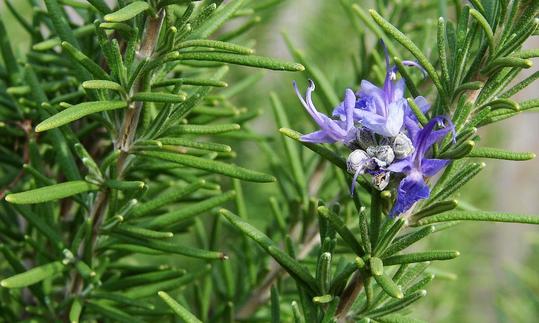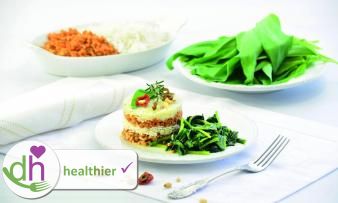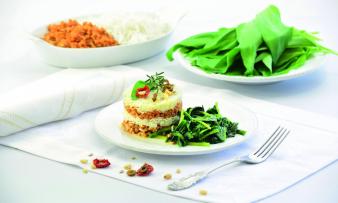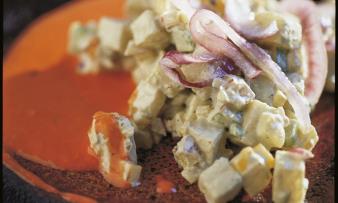Table of contents
Fresh rosemary ( Rosmarinus officinalis or Salvia rosmarinus) is a characteristic spice of Mediterranean cuisine. The medicinal plant, also known as sea dew or rosemary, is used to treat digestive problems, among other things.
Use in the kitchen:
What is rosemary (fresh)? Rosemary is a typical spice shrub used in French, Spanish and Italian cuisine. Rosemary is also an important source of flavor in English cuisine, as well as in the Balkan and Caucasus countries, the USA and Mexico. Rosemary can be used in many different ways, fresh from the bush, dried, in various solutions and as a powder.
Eating rosemary raw: The raw, fresh needles taste bitter and aromatic, smell spicy and pine-like and cause a slightly astringent feeling in the mouth.
What do I use rosemary for? Rosemary is used to season (vegan) herb butter, mushrooms, vegetables, fillings, stews, sauces, salads, potatoes, pasta, marinades, pizzas or soups. Small amounts of ground rosemary go well with jam, jelly or pastries. The flowers can be used to garnish raw salads.
What can you do with fresh rosemary? Raw rosemary sprigs can be preserved whole in vinegar, wine or oil to give sauces and dressings a rosemary flavor. Fresh rosemary, limes or lemons and sugar can be used to make a refreshing syrup. When barbecuing, you can put a fresh rosemary sprig on the coals or rub it into the food you are grilling. Fresh rosemary can only be eaten raw in very small quantities, but it is worth it if there is something like that on your plate in a restaurant. This is the case with apple jelly with rosemary, for example, if you follow the recipe.
A delicate spice mixture is created from salt,pepper, dried thyme, dried rosemary and cayenne pepper in equal parts.
Along with savory and thyme, rosemary is an indispensable ingredient in the well-known herb mixture "Herbes de Provence". The mixtures often also contain lavender, oregano and marjoram, occasionally basil, tarragon, fennel seeds, chervil, bay leaves or juniper berries and rarely lovage, parsley or sage.
Rosemary also combines well with garlic, caraway and onions.
Vegan recipe for savory tartlets with rosemary (fresh):
Ingredients (for two people): 100 g jasmine rice, 100 g spelt, 1 tbsp rapeseed oil, 2 cloves of garlic and 2 fresh sprigs of rosemary.
Preparation: To make the healthy, savoury rice and spelt tarts, first cook the basmati rice (approx. 10 minutes) and the cooked spelt (approx. 30 minutes) in salted water. During the cooking time, gently flavour the rapeseed oil in a pan with garlic, fresh rosemary (raw, not dried), salt and pepper. Layer by layer, fill the hot, cooked spelt and basmati rice into small, round moulds and press the individual layers firmly. Then turn the tarts out onto plates and drizzle the warm oil over them.
A quick spinach made from wild garlic, chard, spinach, Good King Henry, purslane, kale, nettles or ground elder is a good side dish. To do this, roughly chop the washed leaves and briefly sauté them at a medium temperature until they collapse. Finally, you can season the spinach preparation to taste with salt, pepper, ground ivy or garlic mustard.
The complete recipe for the healthy and spicy rice-spelt tarts with wild garlic and spinach can be found HERE.
Recipe for making tea with (fresh) rosemary:
Pour 1-2 teaspoons of rosemary leaves with 250 ml of boiling drinking water and let the herbal infusion steep for 10-15 minutes. Drink this three times a day. 1,2
A tried and tested tea blend for a relaxing, calming tea contains 30 g of lemon balm leaves, 20 g of angelica root, 20 g of hop cones, 10 g of rosemary, 10 g of lavender flowers and 10 g of chamomile flowers. 2
For rosemary baths, briefly boil 50 g of the medicinal herb (rosemary leaves or needles) in one liter of water and then leave covered for 15-30 minutes. Pour the aqueous rosemary extract solution through a sieve and add it to the bath. 3 There is also organic "Spanish rosemary oil" that can be added to the bath water.
Apple jelly with rosemary is also a popular recipe.
Vegan recipes with fresh rosemary can be found under the note: " Recipes that have the most of this ingredient ".
| Not only vegans or vegetarians should read this: Vegans often eat unhealthily. Avoidable nutritional errors. |
Shopping - where can you buy fresh rosemary?
You can buy the fresh herb in controlled organic or conventional quality in grocery stores, health food stores, organic shops, directly from the farmer, at the weekly market, in the so-called green box or seasonal box or online. If fresh rosemary has brown tips, you should avoid it.
During the season from April to September, fresh rosemary is available in raw or raw food quality as bunched goods at Coop, Migros, Denner, Volg, Spar, Aldi, Lidl, Rewe, Edeka, Hofer etc. or in organic supermarkets such as Denns or Alnatura.
The mono-medicinal herb is rarely used as a tea ("tea made from fresh rosemary"). The leaves or needles are often part of tea blends for cardiovascular or nervous complaints. Calming teas contain 5 g of rosemary per 100 g of tea according to standard approval. 3
In addition to fresh rosemary, important commercial forms are the dried needle-shaped leaves, rosemary extract largely freed of essential oil, essential rosemary oil and rosemary oleoresin (leaf extract). 4 Phytopharmaceutical products containing rosemary include rosemary fluid extracts, tonics, pain and rheumatism ointments, muscle creams and rosemary oil, which can be added to baths, ointments, oils, soaps and shampoos. 3
You can read where the commercially available goods come from in the chapter "Cultivation - Harvest" below.
Found in the wild - Season:
True rosemary is a diverse, aromatic, evergreen subshrub that can reach heights of 0.5 to 2 m. The upright and partially prostrate branches bear tough, blunt, needle-like leaves up to 2.5 cm long. The tubular, two-lipped flowers are pale to dark blue, rarely pink or white, and are arranged in whorls in the upper part of the branches. The fruit breaks down into four brown adeniums. 1,4,5
Rosemary can be found in the Mediterranean region growing wild on dry, sunny slopes, on limestone, in sparse bushes and on the edges of forests. 6 There, the typical Mediterranean plant flowers as early as January, and further north from March to July. North of the Alps, rosemary is mainly found in gardens. 1 Season: The foliage and flower tips are preferably harvested in spring and early summer. Rosemary can be harvested all year round for personal use. 1,4,5,6
The medicinal drug comes largely from wild collection. 3,4
Storage:
Fresh rosemary leaves can be stored in plastic bags in the refrigerator for a few days. Chopped and mixed with water, they can be frozen, e.g. filled into ice cube trays. 4
For long-term storage, fresh rosemary leaves should be dried quickly but carefully. Drying temperatures above 35 °C should be avoided in order to preserve as much of the essential oil as possible. 1
Plastic containers are unsuitable for storing rosemary as they have a negative effect on the essential oil. 3 Dried rosemary leaves should be stored in tightly sealed glass, porcelain or metal containers, protected from moisture and light. This way, the leaves can be kept for several years without significant loss of aroma. When ground, rosemary quickly loses its aroma. 4
Rosemary: Ingredients - Nutritional Value - Calories
Rosemary ( Rosmarinus officinalis) contains 1.0-2.5% essential oil. According to the European Pharmacopoeia, rosemary leaves (Rosmarini folium - Pl. R. folia) must contain at least 1.2% essential oil. The oil is located in the glandular scales on the leaves. 3
Rosemary oil is also monographed in the European Pharmacopoeia. A distinction is made between oils of Spanish, Moroccan and Tunisian origin. The main components are 1,8-cineole, camphor, α-pinene and borneol. The ratio of these terpenes varies depending on the origin and chemotype. 3,7
Other ingredients are bitter diterpene phenols (including 0.35% carnosic acid), approx. 3% Lamiaceen tannins (with rosmarinic acid), flavones, flavone glycosides, triterpenes, lipids, carbohydrates, 3 melatonin, resins, flavonoids and some saponin. 1
The complete ingredients of fresh rosemary, the coverage of the daily requirement and comparison values with other ingredients can be found in our nutrient tables in CLICK FOR below the ingredients picture.
Health aspects - effects:
There are numerous publications on the pharmacological effects of rosemary and some of its active ingredients. The effects are usually based on individual animal experiments ( in vitro or in vivo), rarely on humans. 4
Extracts from rosemary leaves have been shown to have various effects: in vitro, the extracts had antibacterial and antiviral effects (against herpes simplex type 2) as well as antioxidant effects. In vitro and in vivo, they had spasmolytic effects (antispasmodic). Diterpenes from rosemary leaves were found to have inhibitory effects on lipid peroxidation (oxidative degradation of fatty acids). Leaf extracts influenced the glucose levels in mice. 3
Experiments have also shown a positive effect on the heart's ability to contract, increased coronary blood flow, and anti-inflammatory and analgesic properties. When applied externally, rosemary leaves have a skin-irritating and circulation-stimulating effect. 7
The mechanism of action for rosmarinic acid (aromatic, essential oil drug) has been proven. Rosmarinic acid inhibits prostaglandin synthesis. 7
Dangers - Intolerances - Side effects:
If you stick to the dosage of rosemary leaves, see daily dose under "Use as a medicinal plant", there are no side effects to worry about. After taking large amounts of rosemary oil, side effects such as stomach, intestinal and kidney irritation can sometimes occur. 1
In the case of bile duct problems or liver disease, rosemary leaves or rosemary oil should only be taken under medical supervision. Pregnant women should also refrain from taking preparations containing rosemary leaves internally, as components of the essential oil can cause toxic side effects. 3
A rosemary bath in the evening can disturb sleep as it has an invigorating effect. 11
Use as a medicinal plant:
The parts of the plant used medicinally are the leaves (Rosmarini folium) and the rosemary oil obtained from them (Rosmarini aetheroleum). 1
According to the HMPC ( Committee for Herbal Medicinal Products), internal applications include digestive complaints and mild cramp-like gastrointestinal complaints. Externally, the herbal medicinal drug is used as a bath additive or rub (oil) for mild muscle and joint pain and for circulatory problems. 3
ESCOP ( the umbrella organization of national European societies for phytotherapy) recommends taking it internally to improve liver and gall bladder function and for digestive problems. Externally, rosemary can be used to support the treatment of rheumatic diseases, for circulatory problems and as a mild antiseptic to promote wound healing. 3
Commission E ( Expert Commission for Herbal Medicines) lists digestive complaints (dyseptic complaints) as an indication for internal use. Rosemary can be used externally to support the treatment of rheumatic diseases and circulatory problems. 3
The daily dose for internal use is 4-6 g of rosemary leaves or 10-20 drops of essential oil. For external use, use 50 g of rosemary leaves for a full bath. Semi-solid and liquid preparations contain 6-10% essential oil. 7
Folk medicine - naturopathy:
Rosemary (rosemary) is rarely mentioned in the writings on ancient medicine. Rosemary played a larger role from the Middle Ages onwards. Indications were described by Pseudo-Apuleius ( Apuleius Platonicus or Apuleius Barbarus), who was influential in northern European medicine from the 4th to the 12th century. 8,9 The medicinal plant was later mentioned in 1435 in the comprehensive herbal encyclopedia Leipziger Kräuterkunde. Rosemary was administered as a stimulant and tonic for weakness, exhaustion and pain. 8 When the priest, hydrotherapist and naturopath Sebastian Anton Kneipp gave rosemary his blessing in the 19th century, this medicinal plant dominated folk medicine in German-speaking countries. 1
Current indications in traditional medicine are during recovery, but also in cases of coronary heart disease, chronic liver disease and to increase appetite and gastric juice secretion. 7
Other uses in modern folk medicine include digestive support, headaches, migraines, bronchitis, colic, respiratory infections, urinary tract diseases and painful menstruation. Rosemary wine is popular for menstrual problems, heart problems and nervousness. Rosemary is used externally to treat hair loss. Rosemary oil is used in the form of ointments, rubs or baths for rheumatic complaints, circulatory problems, exhaustion, bruises, strains and sprains. 4
In Indian medicine, rosemary is used as an antispasmodic for kidney colic, painful menstruation and bronchitis, as well as to promote hair growth. 4 Rosemary is also considered to have an exceptionally warming effect. 8
Occurrence - origin of rosemary:
Rosemary grows wild in the western and central Mediterranean. In the eastern Mediterranean, the plant has been cultivated since ancient times. There, the so-called sea dew occasionally grows wild and sometimes even forms stands. 10
Rosemary is native to southern Europe, particularly the coastal regions of the western and central Mediterranean: Portugal, Spain, southern France, Italy, Greece, Turkey, Morocco, Tunisia and the Caucasus region. 4 The plant is common on dry, sunny and calcareous slopes. 1
Rosemary came to Central Europe from ancient Egypt via Benedictine monks in the 9th century. The plant was introduced to England in the 14th century. 4
Growing in the garden or as a potted plant:
What location does rosemary need? For growing in the garden as an ornamental and herb plant, a sunny location with permeable and neutral soil is suitable. Rosemary tolerates pH values between 5 and 8. 5
Is rosemary winter-hardy? Rosemary does not tolerate cold, wet winters and prolonged frosts. In cold regions, rosemary should be grown in sheltered places or as a pot plant so that it can be overwintered in the pot if necessary. 5 North of the Alps, rosemary is usually winter-hardy in warmer areas, e.g. in wine-growing regions. 6
To encourage bushy growth, the plant can be cut back after flowering. The plant can be propagated by spring sowing or semi-ripe cuttings. 5
Rosemary is a very diverse species. Well-known varieties include 'Suffolk Blue', 'Blue Tuscan', 'Santa Barbara' (blue flowers), 'Logee's Light Blue', 'Benenden Blue', 'Goodween Creek', 'Herb Cottage', 'Russian River', 'Salem', 'Majorca Pink' (pink flowers), 'Albus', 'Albiflorus' (white flowers), 'Miss Jessup's Upright' and 'Arp' (pale blue flowers). Prostrate or semi-prostrate varieties are 'Prostratus' (suitable for pot and hanging basket cultivation) and 'Severn Sea'. 4 All of them can be eaten raw.
Rosemary plants can be purchased as seedlings or as ornamental plants in garden and building supply stores.
Cultivation - harvesting rosemary:
The main areas where rosemary is grown are the Mediterranean countries of Spain, Portugal, southern France and North Africa, as well as India, South Africa, Australia, Mexico, Crimea, the Philippines, the USA and the Antilles. 4 The main countries supplying rosemary are Spain, Turkey, France, Italy, Morocco and Tunisia, as well as countries in southeastern Europe. The commercial harvest takes place during or after flowering. 4 As mentioned, the medicinal herb is mostly collected in the wild. 3,4
In England's climate, which is influenced by the Gulf Stream, rosemary can be cultivated on a larger scale. 2 When it comes to rosemary, fresh means raw or freshly harvested, whether organic or not.
Animal protection - species protection - animal welfare:
Rosemary serves as food for bees mainly during the months of May to September (summer forage). Forage is the general term for the food that the bees bring in, i.e. nectar, pollen and honeydew. The nectar value of rosemary is high and the pollen value is low (nectar value and pollen value scale: none, low, medium, high, very high). The two values reflect the value for insects and serve as guidelines and decision-making aids for bee and insect-friendly new plantings and gardening. 6
Hymenoptera and occasionally moths are among the most frequent visitors to rosemary flowers. 6 Bees also often visit the flowers because they provide a lot of food in the form of nectar. 1
Danger of confusion:
The leaves of common rosemary ( Rosmarinus officinalis) can be confused with those of the highly poisonous rosemary heath (or rosemary heath: Andromeda polifolia). The important distinguishing features are the leaves of the rosemary heath, which can be up to 3 cm long (so slightly longer than those of rosemary), their spherical corolla (rosemary flowers are two-lipped and bell-shaped) and their fruit, which is a capsule (rosemary has a herb with four seeds). 11
In the Northern Hemisphere, heather is widespread in heathland and moorland landscapes in Eurasia and North America.
General information about rosemary:
According to Wikipedia , Rosmarinus officinalis was classified as a genus in the genus Rosmarinus in the mint family (Lamiaceae). 9 Rosmarinus officinalis included the three subspecies Rosmarinus officinalis subsp. officinalis, Rosmarinus officinalis subsp. palaui and Rosmarinus officinalis subsp. valentinus. According to recent research, these subspecies or varieties are now grouped together under the name Salvia rosmarinus Spenn. in the genus Salvia ; Salvia rosmarinus has replaced Rosmarinus officinalis as a synonym. 12,13
The name rosemary probably comes from the Latin ros marinus and means "dew (ros) of the sea (marinus)", i.e. "sea dew". An older interpretation of the name's origin refers to the Greek term rhops myrinos (balsamic shrub). There may also be an onomastic connection between the Greek words libanotis (rosemary) and libanos (incense).
Alternative names:
Alternative names for rosemary are Anthoskraut, hochzeitskleid, Hochzeitsbleaml, Kid, Meertau, Röselimarie, Weihrauchkraut, Krankrautblätter, Kranzenkraut or Kranzenkrautblätter. We also found the spellings Rozmarin and Rosmarien. The spice is called Rozmarin mainly in Romania or Rožmarin in Slovenia.
In English, rosemary is called rosemary or anthos. In Spanish, the plant is called romero - and rosemary (fresh) is called romero fresco or romero (hierba).
Keywords for use:
As a bitter agent in beer, 9 as an ingredient in the liqueur industry (component of Benedictine or Goldwasser), 3 in the food industry as a preservative and antioxidant, 3 in the cosmetics industry (e.g. in hair tonic, cologne), 4 for the production of room sprays 4 and previously as a substitute for frankincense. 9
Literature - Sources:
Bibliography - 13 Sources
| 1. | Pahlow M. Das grosse Buch der Heilpflanzen. Gesund durch die Heilkräfte der Natur. 8. Auflage. Hamburg; 2019. Nikol Verlagsgesellschaft mbH & Co. KG. |
| 2. | Niederegger O, Mayr C. Heilpflanzen der Alpen. Gesundheit aus der Natur von A bis Z. Innsbruck; 2006. Tyrolia-Verlag. |
| 3. | Blaschek W. (Herausgeber). Wichtl – Teedrogen und Phytopharmaka. Ein Handbuch für die Praxis. 6. Auflage. Stuttgart; 2016. Wissenschaftliche Verlagsgesellschaft mbH. |
| 4. | wissenschaftliche-verlagsgesellschaft.de Rosmarin. Rosmarinus officinalis. |
| 5. | Bown D. Kräuter. Die grosse Enzyklopädie. Anbau und Verwendung. 2. Auflage. München; 2015. Dorling Kindersly. |
| 6. | Kremer BP. Mein Garten – Ein Bienenparadies. 2. Auflage. Bern; 2018. Haupt Verlag. |
| 7. | Schilcher H, Kammerer S, Wegener T. Leitfaden Phytotherapie. 3. Auflage. München; 2007. Elsevier GmbH. |
| 8. | Dr. Gerhard I, von Ganski N. Die neue Pflanzenheilkunde für Frauen. 1. Auflage. München; 2011. Verlag Zabert Sandmann GmbH. |
| 9. | Wikipedia Rosmarin. |
| 10. | Oberdorfer E. Pflanzensoziologische Exkursionsflora für Deutschland und angrenzende Gebiete. 8., stark überarbeitete und ergänzte Auflage. Stuttgart (Hohenheim); 2001. Eugen Ulmer Verlag. |
| 11. | Fleischhauer SG, Guthmann J, Spiegelberger R. Enzyklopädie. Essbare Wildpflanzen. 2000 Pflanzen Mitteleuropas. 1. Auflage. Aarau; 2013. AT Verlag. |
| 12. | Drew BT, González-Gallegos JG et al. Salvia united: The greatest good for the greatest number. Taxon. 66(1). 2017: S. 133–145. DOI:10.12705/661.7 |
| 13. | Hong Wu, Peng-Fei Ma et al. Comparative plastomic analysis and insights into the phylogeny of Salvia (Lamiaceae). Plant Diversity 2020. "In Press" am 30.11.2020. DOI: 10.1016/j.pld.2020.07.004. |











Comments